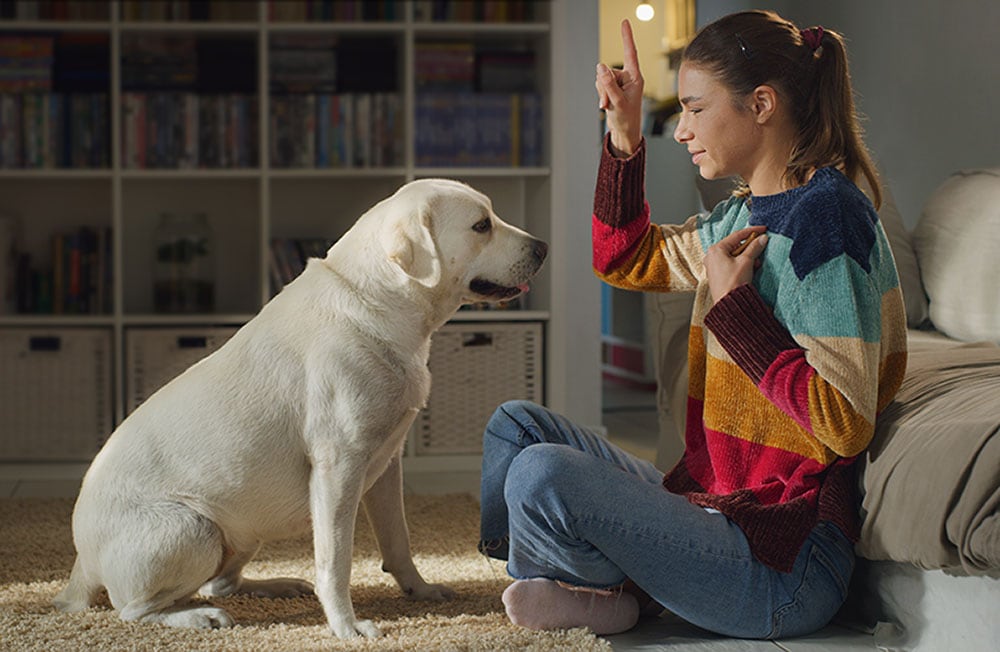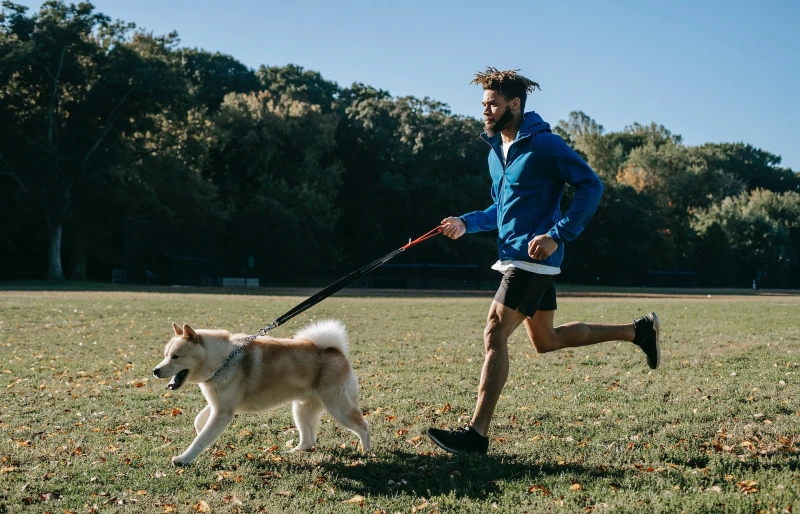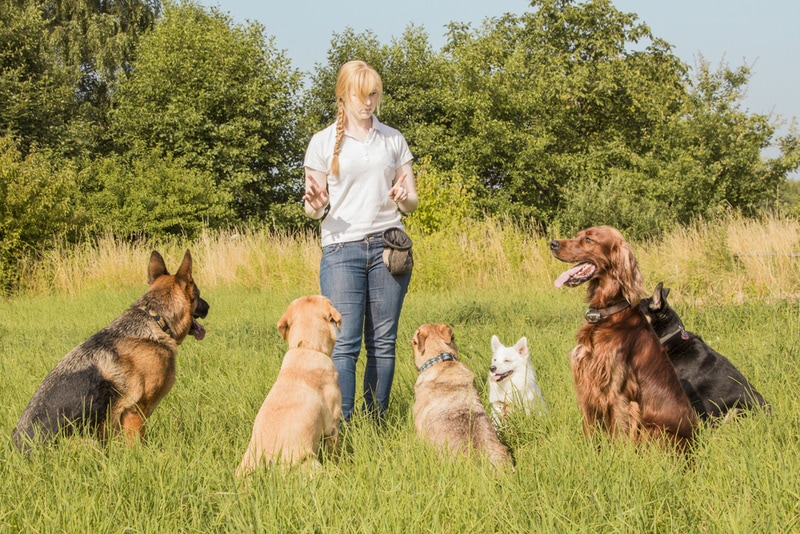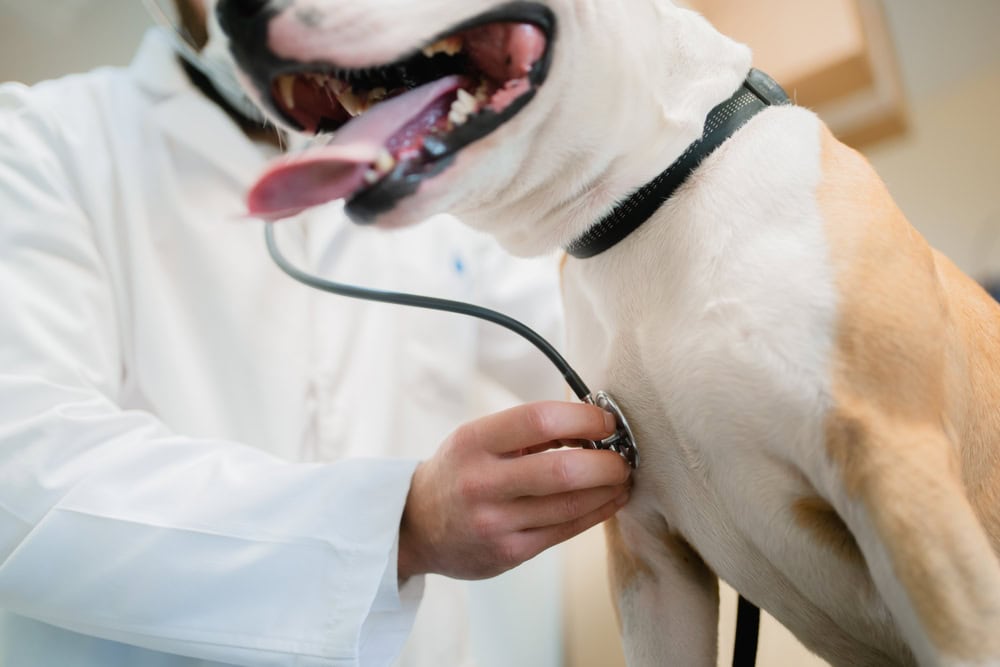VET APPROVED

The information is current and up-to-date in accordance with the latest veterinarian research.
Learn more »Click to Skip Ahead
All dogs have the potential to exhibit dominant behavior, and some breeds are more inclined to be dominant than others. Being the boss has advantages, but if you believe your dog thinks they are in charge of the household, it will take a bit of work to sort out.
Below, we’ll discuss a few of the more obvious signs that a dog is genuinely demonstrating dominant behavior and the steps that you can take to curb this behavior

Why Do Dogs Become Dominant?
What might appear to be a dog demonstrating dominant behavior might be a dog needing extra training, exercise, or enrichment. Sometimes, what looks like dominance is frustration, boredom, or anxiety. A dominant dog can be male or female, though the behavior is more commonly seen in intact (unneutered) males.
Dominant behavior problems commonly start in adult dogs between 18 months and 3 years of age, though they can also be exhibited by older dogs and puppies. They typically show aggressive and controlling behavior toward family members and other dogs, but the signs can also be more subtle.
Factors that can lead to dominant behaviors are as follows.

1. Lack of Socialization
In a pack environment, puppies learn how to interact with other members of the pack, and any antisocial behavior is dealt with swiftly. When pups are young, under 6 months, the adults are more patient and will teach them manners with a bark or growl or the occasional cuff around the ear. They learn:
- Boundaries
- Manners
- Body language
- How to respect those in charge
- How to share
- How hard is too hard when it comes to biting
Pups that do not socialize with other dogs in their first few months lose this vital learning experience. As puppy parents, we often cannot show them the right way to interact with others quite as effectively as other dogs. We usually let them get away with things that their pack never would.
Without proper socialization and training, many dogs will react aggressively, sometimes out of fear. Allowing a dog to display unwanted behaviors, such as jumping on people or begging while people are eating, only reinforces those behaviors.
2. Lack of Training
Dominant behavior issues can occur because of incorrect training methods and a lack of socialization. Training allows us to teach them how to sit, stay, etc., and establishes our place as the one in charge.
When owners allow their dogs to push boundaries, break rules, and get away with things, they inadvertently create a stressful situation for them. Suddenly, they’re not sure who is in charge, and if it’s not you, they will feel that they need to take the lead. So, when they get in trouble for being assertive, bossy, or dominant, it can lead to frustration and aggression.
When you are asserting yourself and your family members as leaders, you are not being mean; you are reducing stress for your dog. This is why it is also important to involve all the family in training activities as much as you can and have them feed the dog,too. It is important that your dog understands that they do not need to compete with anyone, they will be provided for, and they don’t need to stress about being in charge.

3. Sexual Maturity
When their hormones switch on, most dogs suddenly have new urges, which they don’t have to worry about before finding a mate. In females, it is less likely to lead to dominance behaviors, but when they are coming into season, they can become less tolerant, more on edge, and sometimes even aggressive as their bodies tell them to start preparing for male suitors.
For males, their testosterone tells them that they need to be the biggest and best so they can win the right to mate with the females. Suddenly, a once happy-go-lucky dog is trying to prove himself to everyone around him, including you. This can start happening from 6 months old to 3 years old. Once testosterone starts to kick in, you’ll know it.
4. Health Conditions
If a dog is suffering from a medical issue, they might be more inclined to demonstrate dominant behavior. Orthopedic problems, thyroid issues, adrenal gland problems, cognitive dysfunction, or seizure disorders can all lead to a dog acting dominantly and aggressively because they want to control the situation or be left alone.


How Can You Tell When a Dog Is Acting Dominant?
- Resource guarding: Dogs that exhibit resource guarding guard their possessions, such as food, bedding, toys, or their territory in general. This behavior can include stiffening, growling, snapping, and biting.
- Ignoring or resisting: Dogs that ignore or resist commands can demonstrate dominant behavior.
- Aggression: If a dog stares, growls, snaps, barks, and bites at people and other animals, this can be a sign of dominant behavior.
Not every dog showing these signs necessarily exhibits dominant behavior, but they are the most common.

The 10 Steps to Stop Dominant Dog Behavior
1. Make Sure Everyone Is Safe
Once you’ve identified that your dog is displaying dominant behavior, ensure everyone is safe. This can include removing other pets and family members from the area and giving your dog more space.

2. Remain Calm
You must stay calm and not respond to any unwanted behavior from your dog. If you respond either verbally or physically, your dog will take your response as an indication that you are actively participating, which can lead to the behavior continuing or worsening.
Dogs can also pick up if you’re feeling a strong emotion, such as fear or anxiety. Your dog is more likely to remain calm if you are as well.
3. Start From Day One
It is so easy to let things slide when your puppy is a tiny ball of cuteness. But even if you are bringing an older dog into the home, the rules must be established from the start.
With puppies, you should be able to take food or toys from them at any point. If you are met with resistance, persist until there is none. You must be able to do this, but it is equally important that your dog understands that they will get the food/toy back.
If you need to take something away that they can’t have back, like items they will want to chew/eat/play with, be sure to reward them with petting, a treat, or another item so they associate giving things up with a positive experience.
This can be a little trickier if you have adopted an older dog, but once you have established a bond, you should be able to implement the boundaries. Talk to your vet or a behaviorist for guidance if needed.
4. Give Clear and Consistent Direction
You must establish what the rules are, and they must be clear and consistent. Everyone in the family must stick with the same rules. For example, if you’ve made it a rule that the dog should stay off the furniture, everyone in the household must address this issue when your dog jumps on the couch, even in your absence.
Communication with your dog must be clear, and you should never make allowances just because your dog looks cute. This only teaches them that they can get away with naughty behavior. You should always be firm yet patient.
Don’t forget to reward your dog when they are being calm and relaxed. It is really hard to remember to reward them when they’re technically not doing anything.

5. Respect Their Space
If your dog doesn’t seem to be in the mood to interact with anyone, leave them alone. You should never force interactions with your dog when they want to be left alone.
Let them approach you on their own terms, and reward them when they come to you calmly and non-threateningly. This can be with treats, praise, or pets.
6. Provide Positive Reinforcement
Positive reinforcement is the most accepted training method because it teaches dogs that they will receive something positive for specific behavior. It starts simply enough, such as giving your dog a treat when they sit after you give the command to “sit.” Eventually, your dog will learn that something good happens when they hear that command, and they will sit willingly.
Never punish your dog for doing an unwanted behavior; this will only confuse them and cause them to fear you. It will also likely exacerbate the aggression problem. Try heading problems off at the pass. If you see a potential problem, redirect your dog.
For example, if your dog is reactive to other dogs while out for a walk, when you see a dog approaching, change your course and walk in a different direction. Don’t forget to reward your dog when they are calm.
7. Give Them Plenty of Exercise
A tired dog is less likely to misbehave. Furthermore, if a dog isn’t getting enough exercise, it can lead to behavioral problems. Check with your vet how much exercise your dog needs, and ensure they get it.
Some breeds are highly energetic and require as much as 2 hours of exercise daily. Staying on top of their exercise needs will help them expend excess energy and mellow them out.

8. Give Them a Job
Some breeds need a job to stay busy. Border Collies, for example, are famous for their shepherding skills. Without enough activity, they will attempt to herd everyone in the home, so you should enroll them in herding trials.
Most dogs benefit from obedience and agility training. It gives them a physical and mental outlet and strengthens their bond with their owners.
9. Spay or Neuter Them
Unless you are planning on breeding your dog, it is recommended that you spay or neuter them for several reasons. For females, spaying between their first and second seasons will significantly reduce their risks of mammary cancer and eliminate their risk of womb infection (pyometra).
In most cases, an intact male dog will likely hump more and pee on every tree, lampost, or leg they encounter and will sometimes be frustrated that they can’t go running off in search of females. This can lead to dominant behaviors and redirected aggression. When males are castrated in the very early stages of this hormonal upsurge, their sudden need to dominate can often be avoided.
Castration tends to be met with more resistance from owners than spaying, but it is helpful not to think of it as emasculation but rather as removing a source of stress and frustration. If they’re never going to get to use them, they will be far more relaxed if they’re gone!
Talk to your vet about when to spay or neuter your dog.
10. Get Professional Help
If you’re struggling to help your dog, speak to your vet. They can provide tips or refer you to an animal behaviorist. Most dog experts employ behavior modification to calm down dominant canines.


You Are Not the Alpha
No matter what you might have heard, “the alpha dog” theory is no longer accurate. In 1947, animal behaviorist Rudolph Schenkel wrote “Expressions Studies on Wolves,” which is the seminal study that started the whole “alpha” theory. Schenkel studied wolves in captivity in a zoo, where he witnessed wolves fighting for dominance. The wolf that won became the leader, or “alpha wolf.”
However, it’s been discovered that wolves in the wild do not behave the same way as captive wolves and are instead more of a family unit. Most wolf packs contain two adults, referred to as “parents” or “breeders,” and their offspring. David Mech developed this new theory in 1999, and he wrote the study “Alpha Status, Dominance, and Division of Labor in Wolf Packs.”
The key takeaway is that you can’t approach your dog as though you’re the “alpha.” You’re not a dog, so no dog will ever think of you as one of them. Essentially, you should approach your dog as a compassionate leader who will support their successes and try to help them when they fail.
Stick with positive reinforcement and avoid tough love or punishment at all costs. If they look to you and your family for guidance on how to react and behave, they will feel much happier and less stressed.

Conclusion
Many dogs that show dominant behavior are doing so because they need more training and support. Speak to your vet about your concerns, and they can advise you. Don’t hesitate to sign your dog up for a training program or with an animal behaviorist if you’re struggling.
Also, you should never use intimidation tactics or punishment. Be clear about what you want them to do and not do, and reward them appropriately. Remember, sometimes, that means rewarding them for doing nothing!
See also:
- 7 Neurological Issues in Dogs & Common Signs to Keep in Mind (Vet Answer)
- How Should I Introduce My Puppy to a Dominant Dog? 6 Vet Approved Tips
Featured Image Credit: mezzotint, Shutterstock
How useful was this post?
Click on a star to rate (you can leave written feedback after clicking submit)
Help us improve Hepper for pet parents!
Your feedback really matters.
What did you like about this post? Also how can we improve it?






















